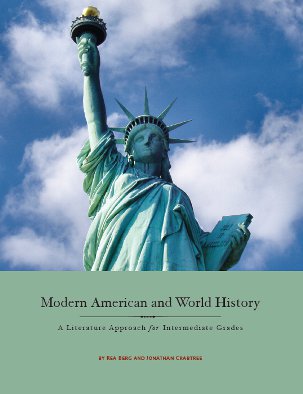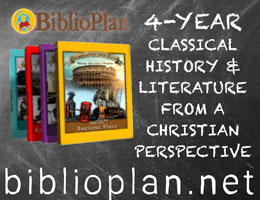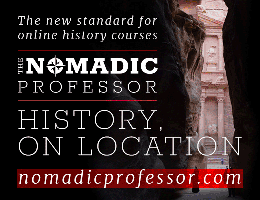Modern American and World History: A Literature Approach for Intermediate Grades is an interesting amalgam of Charlotte Mason methodology and the “4R” method: Read, Reason, Relate, and Record (from the Principle Approach®). While Beautiful Feet’s Literature Approach to History guides originally started out with a strong reliance on the Principle Approach, they have moved away from it over the years, gravitating toward some Charlotte Mason methodology while retaining the Principle Approach’s “4R” terminology. The result is a curriculum that can be taught more or less with Charlotte Mason methodology depending upon how it is implemented. As I describe the course, I’ll indicate which method a learning strategy supports by PA (for Principle Approach) or CM (for Charlotte Mason approach). You might want to stress particular strategies depending upon your preferences. You should also select lesson activities that are most suitable for the abilities of your student(s) rather than expecting all students to do everything.
Rather than texts or textbook type material, students read from 22 literary works—historical novels, biographies, autobiographies, and poems—plus selected chapters from two “spine” books, A Child’s First Book of American History (published by Beautiful Feet Books) and Joy Hakim’s A History of US: All the People (CM). Modern American and World History is your guide for using all of these resources. This might sound like a lot of resources, but consider that the guide is trying to cover both world and U.S. history from 1860 to the present. A literature approach necessitates being selective about topics that are covered. The role of the spine books is to fill the gaps for complete coverage. (If you find yourself pressed for time or your child is overwhelmed with reading, consider substituting additional chapters from spine books for one or more literary works.) The selected literature does a surprisingly good job of covering the vast amount of history. Coverage through the literary works is lighter on the most current history. The last complete book read is a biography of Ronald Reagan, and more-current history is covered only through A History of US: All the People.
As the guide explains on the first page, the time period from the 1860s through the twentieth century was dominated by military conflicts that “drew countless millions into their webs of darkness, destruction, and death.” The guide continues, “Because this view of humanity can become distressing to readers, we have attempted to balance the otherwise overwhelming turmoil of the period with inspiring stories of heroic individuals who stood for justice, truth, equality, and freedom in the midst of great challenges.” So, while students read Twenty and Ten about the Nazi occupation of France and Air Raid-Pearl Harbor!, they also read Number the Stars, the story of a heroic Danish girl who helps to save a Jewish family. Examples of other literary works used for this study are The Perilous Road, Carver: A Life in Poems, The Wright Brothers: Pioneers of American Aviation, The Singing Tee, Rascal, The House of Sixty Fathers, War Boy: A Wartime Childhood, and Water Buffalo Days: Growing Up in Vietnam.
While there are general instructions at the beginning of the guide, daily lesson plans assign reading from the various books, discussion questions, and writing assignments, and they sometimes have pertinent weblinks or suggested movies to watch. While CM methodology would allow a child to provide narration based upon his or her own selection of what was important or interesting, this guide prescribes discussion questions and assigns particular writing assignments (PA). Questions are sometimes simple comprehension questions, but they more frequently engage students at deeper levels of thinking with questions such as, “Discuss whether it is right for Sam Gardiner to take the law into his own hands to stop Guy Wortman’s mob attacks” (p. 3). Suggested answers are at the back of the guide.
Writing assignments include a number of lengthy pieces. For example, “…write a brief biography on the life of Gladys Aylward” (p. 32). This assignment is followed by further instructions about what to write and how to write it. A few of the other assignments are writing a paper on a significant battle of the Civil War and writing a persuasive speech on the importance of freedom for all men (after reading about Frederick Douglass) (PA).
The full-color guide includes historical overviews, sidebars, and illustrations that are often critical components of the course. The instructions at the beginning of the book direct students to create a notebook for all of their work (PA). In their notebooks, students create a glossary in which they will write specific words and definitions for unusual or challenging vocabulary words they are going to encounter in the next book they read. All other work for the course also goes in the notebook: pictures, maps, reports, composition work, poetry, and copy work (PA). A general instruction at the beginning of the book suggests that students do copy work, but no specific copy work assignments are given—it’s up to you to select passages for copy work (CM). A free downloadable file provides six pages for map work to be used with the course.
There are 117 lessons in the book, so students need to complete three to four lessons per week to complete the course in one school year. It is not unusual for one day’s assignment to require reading two or three chapters from the assigned books, so this course is likely to work best for students who enjoy reading. (It would be difficult to cover all of the reading as read-alouds!) While the course is recommended for grades five through eight, completing all of the reading and writing should be manageable for the upper two grade levels, but you will probably want to lighten the load for fifth and sixth graders.
As far as religious perspective, even though Gladys Aylward is the story of a Christian missionary, the study as a whole should be suitable for those of various religious or non-religious persuasions.
The guide is available in either print or downloadable formats. Beautiful Feet Books sells all of the required books individually, but they also have a discounted package of the guide plus all of the other required books.
Summary
I have found few interesting resources for studying Modern World History at the junior high level, so I was particularly pleased to discover this literature-based course. While using “living books” takes more time, students are much more likely to remember the historical events and gain a more nuanced sense of history that goes beyond names and dates. The use of the two spine books addresses concerns about topics that are missed when you rely solely on the selected literary works.













